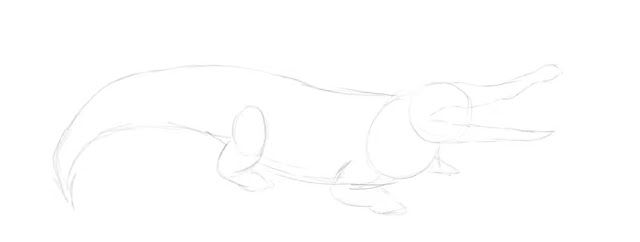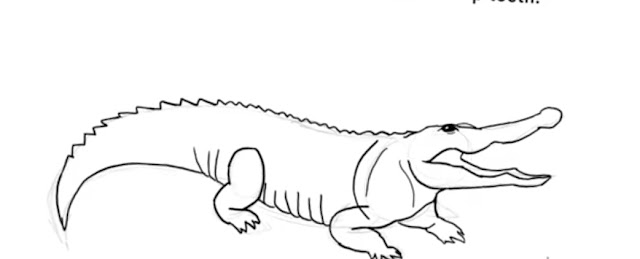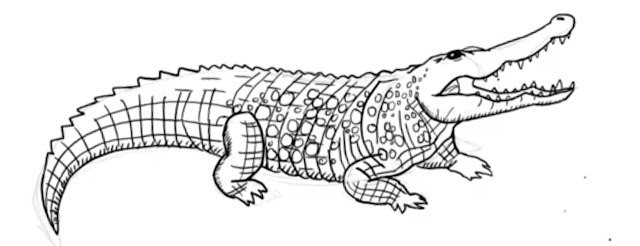Drawing alligators is an interesting subject for artists. Alligators are large reptiles, most commonly identified by their broad, rounded horns, and a profusion of pointed, sharp teeth.
They are always visible in lakes, ponds, rivers, and slow-moving gutters. Drawing a realistic alligator is a fulfilling and enjoyable cultural task.
Draw An Easy Realistic Alligator: A Step-by-Step Guide to Capturing the Majestic of Everglades
Imagine yourself meandering through the Everglades' verdant, steamy wetlands, the aroma of moss filling the air, and you can hear the distant noises of wildlife. Just above the surface of the water, you notice the sudden glimmer of an alligator's eye; its scaly, rough skin blends in perfectly with the murky surroundings. It may seem impossible to capture this magnificent creature on paper, but with the appropriate methods, you can render every aspect vividly.
Come along on this creative journey with me as we go over the steps involved in creating a realistic drawing of an alligator, from its ferocious eyes to its complex hide patterns. This guide will teach you the art of the alligator and leave you with a work of art fit for the wild, regardless of your level of experience as an artist.
This drawing guide will teach you how to draw an alligator realistically. I'll divide the procedure into doable steps, such as assembling supplies, researching the dismantling of alligators, drawing basic shapes, including details, and refining your definition.
Now proceed in this manner.
Head: The larger, rounder conk tends to have a U-shaped appearance in most cases. This conk can be used with strong bite power particularly effective for breaking and mashing hard prey such as turtles.
BODY: With a muscular, flat tail, both males and females have an armored body. Osteoderms, also known as scutes, are bedded bony plates that encase the skin on their reverse. While young animals have bright, non-heroic stripes on their tails, adults have dark stripes on theirs.
Ears and eyes: To provide visibility in the water, the consciousness and eyes are situated on top of the head.
Legs: Webbed bases on sturdy short legs.
Draw the introductory figure by tracing the outline of the body (start with a round, perpendicular shape for the body). The alligator's general structure will be established by doing this.
Think and stutter: Attach a lower round shape for the head, at one end of the body, To create the conk, extend the front of this round. making sure the tip is wide and gently rounded.
Place your nose close to the conk's tip.
Add the mouth, which extends from the conk dot. almost to the head's base. The lower and upper jaws should gently lap one another.
Texture of the body and tail:
Sketch on scale. Large, somewhat thick scales, particularly on the reverse, are characteristic of alligators.
Redraw your original sketch to emphasize the shapes and lines with a darker pencil or pen.
To make the art look neater, eliminate unnecessary guidelines and draw lines precisely.
Shading and texture: To create a three-dimensional appearance, start by shadowing the alligator. For areas that need more depth, use colored pencils (HB for lighter areas, 2B for darker areas, and 4B for darker areas).
When necessary, blend in and add subtle shadowing to give the scales more texture. Use cotton hearties or blending refuse to improve the shading.
Study real alligator images to understand the intricate details, textures, and proportions of animals. This will bring out the best in your artwork.
Practice sketching reptiles regularly because they have complex structures and textures that can be difficult to draw. You can improve your chops by practicing harmoniously. At every stage of the illustration process, practice tolerance. It takes patience and close attention to detail to get a realistic sketch.


Draw straight dimension lines across the back and tail of the creature, beginning at the reverse with larger scales and progressively getting smaller as you approach the edges.
Crests: On the body and tail, draw blocky scales that gradually get smaller toward the sides and larger on the reverse.
Legs: Sculpt the leg muscles to accentuate their robust structure.
Feet: Attach pointy nails to the tips of each toe and place fleshy bands in between.

Using a darker pencil, overdraw your initial outline to enhance the forms and outlines. This will add more detail to your drawing. Erasing lightly makes broad lines and removes any unnecessary markings. Gradually add more intense shading and three-dimensionality to your artwork by starting with the lightest corridor and working your way slowly up to the most violent. Blend as necessary to create smooth transitions. 

MATERIALS YOU NEEDED
The following supplies are needed before you begin:
- A sketchbook or drawing paper: A good runner is necessary for a mess-free delineation.
- Pencils (HB 2B and 4B)
- A regular or sculptured eraser
- A sharpener.
- Mixing waste cotton hearties.
Now proceed in this manner.
Step One. Work at Alligator Anatomy:
Preparing a realistic drawing requires working on the alligator's anatomy or comprehending its structure. The unique features andHead: The larger, rounder conk tends to have a U-shaped appearance in most cases. This conk can be used with strong bite power particularly effective for breaking and mashing hard prey such as turtles.
BODY: With a muscular, flat tail, both males and females have an armored body. Osteoderms, also known as scutes, are bedded bony plates that encase the skin on their reverse. While young animals have bright, non-heroic stripes on their tails, adults have dark stripes on theirs.
Ears and eyes: To provide visibility in the water, the consciousness and eyes are situated on top of the head.
Legs: Webbed bases on sturdy short legs.
Step 2: SKETCHING DRIVE FIGURE
Outline the body.Draw the introductory figure by tracing the outline of the body (start with a round, perpendicular shape for the body). The alligator's general structure will be established by doing this.
Think and stutter: Attach a lower round shape for the head, at one end of the body, To create the conk, extend the front of this round. making sure the tip is wide and gently rounded.
Tail: Next, sketch the tail length, which should extend from the opposite end of the body. About the same length as the body is appropriate for the tail.
Legs: Draw four short legs beneath the body to finish the delineation. Position the legs at the front and rear of the body. To symbolize the bases, add tiny spheres or circles to the ends of the legs.
Legs: Draw four short legs beneath the body to finish the delineation. Position the legs at the front and rear of the body. To symbolize the bases, add tiny spheres or circles to the ends of the legs.
Step 3. Adding details to the head:
HEAD DETAILS
Position the eyes at the top of the head. Generally speaking, alligator eyes are round and small.Place your nose close to the conk's tip.
Add the mouth, which extends from the conk dot. almost to the head's base. The lower and upper jaws should gently lap one another.
Texture of the body and tail:
Sketch on scale. Large, somewhat thick scales, particularly on the reverse, are characteristic of alligators.
Create ridges on the back and tail. These ridges become less noticeable as they get closer to the head and more noticeable near the tail.
Legs and bases: Highlight the muscular structure of the legs by drawing them in more detail. Include netting in the space between the toes and claw tips.
Legs and bases: Highlight the muscular structure of the legs by drawing them in more detail. Include netting in the space between the toes and claw tips.
Step 4: Fine-Tuning the Drawing
Figures and Eliminating GuidelinesRedraw your original sketch to emphasize the shapes and lines with a darker pencil or pen.
To make the art look neater, eliminate unnecessary guidelines and draw lines precisely.
Shading and texture: To create a three-dimensional appearance, start by shadowing the alligator. For areas that need more depth, use colored pencils (HB for lighter areas, 2B for darker areas, and 4B for darker areas).
When necessary, blend in and add subtle shadowing to give the scales more texture. Use cotton hearties or blending refuse to improve the shading.
FINAL TOUCHING
Make sure that you pay attention to the smallest details, like the mouth and eyes. For a more realistic appearance, add highlights to the eyes.Directions for Drawing an Alligator:
Examine your delineation's overall balance and proportions and make any necessary final adjustments to ensure the alligator looks realistic and naturalistic.Study real alligator images to understand the intricate details, textures, and proportions of animals. This will bring out the best in your artwork.
Practice sketching reptiles regularly because they have complex structures and textures that can be difficult to draw. You can improve your chops by practicing harmoniously. At every stage of the illustration process, practice tolerance. It takes patience and close attention to detail to get a realistic sketch.
Drawing created step-by-step
Let's dissect a thorough drawing to ensure complete integration. To complete a convincing alligator sketch, adhere to these stages.Step 1: Sketch the Basic Outline
Create a large, rounded shape for the body and a long, narrow form for the tail. Head and keel. Next, draw the head's lower circle, lengthening it to create a broad conk. Dot Legs Ultimately, draw four short legs emerging from the body. At the tips of these legs place tiny circles to indicate the bases.Step 2: Adding Details to the Head, Nostrils, and Eyes:
Draw small circular eyes at the top of the head and place the nostrils close to the conk. The mouth of the conk produces a false line. to show the mouth right before the base of the head.
Step 3: Detailing the Body and Tail Scale:
Draw straight dimension lines across the back and tail of the creature, beginning at the reverse with larger scales and progressively getting smaller as you approach the edges.Crests: On the body and tail, draw blocky scales that gradually get smaller toward the sides and larger on the reverse.
Step 4: Completing the Legs and Bases.
Legs: Sculpt the leg muscles to accentuate their robust structure.Feet: Attach pointy nails to the tips of each toe and place fleshy bands in between.
Step 5: Refining and Shadowing
Using a darker pencil, overdraw your initial outline to enhance the forms and outlines. This will add more detail to your drawing. Erasing lightly makes broad lines and removes any unnecessary markings. Gradually add more intense shading and three-dimensionality to your artwork by starting with the lightest corridor and working your way slowly up to the most violent. Blend as necessary to create smooth transitions. Step 6: Last Touches
Enhance the eye area with highlights and smooth the subtle details of the mouth. Use blending styles and shading to change the appearance of the scales. Make any final adjustments required to the delineation's overall equilibrium and the scale size.Conclusion:
Realistic alligator drawing takes patience, tolerance, and careful attention to detail. You can develop the ability to portray an authentic alligator by practicing and adhering to these guidelines regularly. Use Filmland as a venue for an experiment, and above all, have fun with the creative process. I hope you have the best possible luck with your design!
You also love how to draw cartoon alligatorFAQS related to realistic Alligator drawing
What are the key features to focus on when drawing a realistic alligator?
- Head and Snout
- Skin texture
- Body structure
- Details
- Proportions and perspective.
How do you use shading to enhance the realism of an alligator drawing?
- Define Light Source: Choose a direction for the light source that is constant.
- To provide depth, use lighter tones on elevated surfaces and darker shades in sunken regions.
- Texture Emphasis: Use shade to draw attention to the scaly, rough texture.
- Shading along the body's curves to highlight muscle is known as contour shading.
- Gradual Transitions: To create a realistic look, use gradual transitions between areas of light and dark.
- Add highlights to the fangs, eyes, and scales to give the appearance of vitality.
- Shadow Placement: To help the alligator feel grounded in its surroundings, cast shadows beneath its torso and tail.
What are common mistakes to avoid when drawing an alligator?
My personal experience says, commonly people make these mistakes:
- Incorrect nose Shape: The broad U-shaped nose is mistaken for a V-shaped one. this is most common in my experience.
- Improper Proportions: Misjudging the sizes of the head, body, legs, and tail. That might also trigger you.
- Lack of Texture: Ignoring the unique rough and scaly skin texture. That's another common mistake.
- Uniform Shading: To show depth and form, use even shading rather than varying tones. this step is most important for your realistic drawing.
- Neglecting Details: Ignoring details such as eyes, teeth, and claws. Must avoid this mistake.
- Flat Appearance: Failure to achieve a three-dimensional effect through adequate perspective. Try to achieve three dimensional effect.
- Inconsistent Light Source: Shading with no consistent light direction. That will destroy your drawing, must avoid this.
- Omitting Skin Folds: Ignore the loose skin folds around the neck and limbs.
- Weak Musculature: A lack of emphasis on muscularity, particularly in the legs and tail. look for a solution.
- Background Disregard: Failure to respect the natural habitat or background features to enhance realism.
The solution is Practice, practice, and practice. wish you a happy journey! Comment if you have any queries, I'm here for you as a guide.
Also, visit creativee drawing ideas for kids

0 Comments